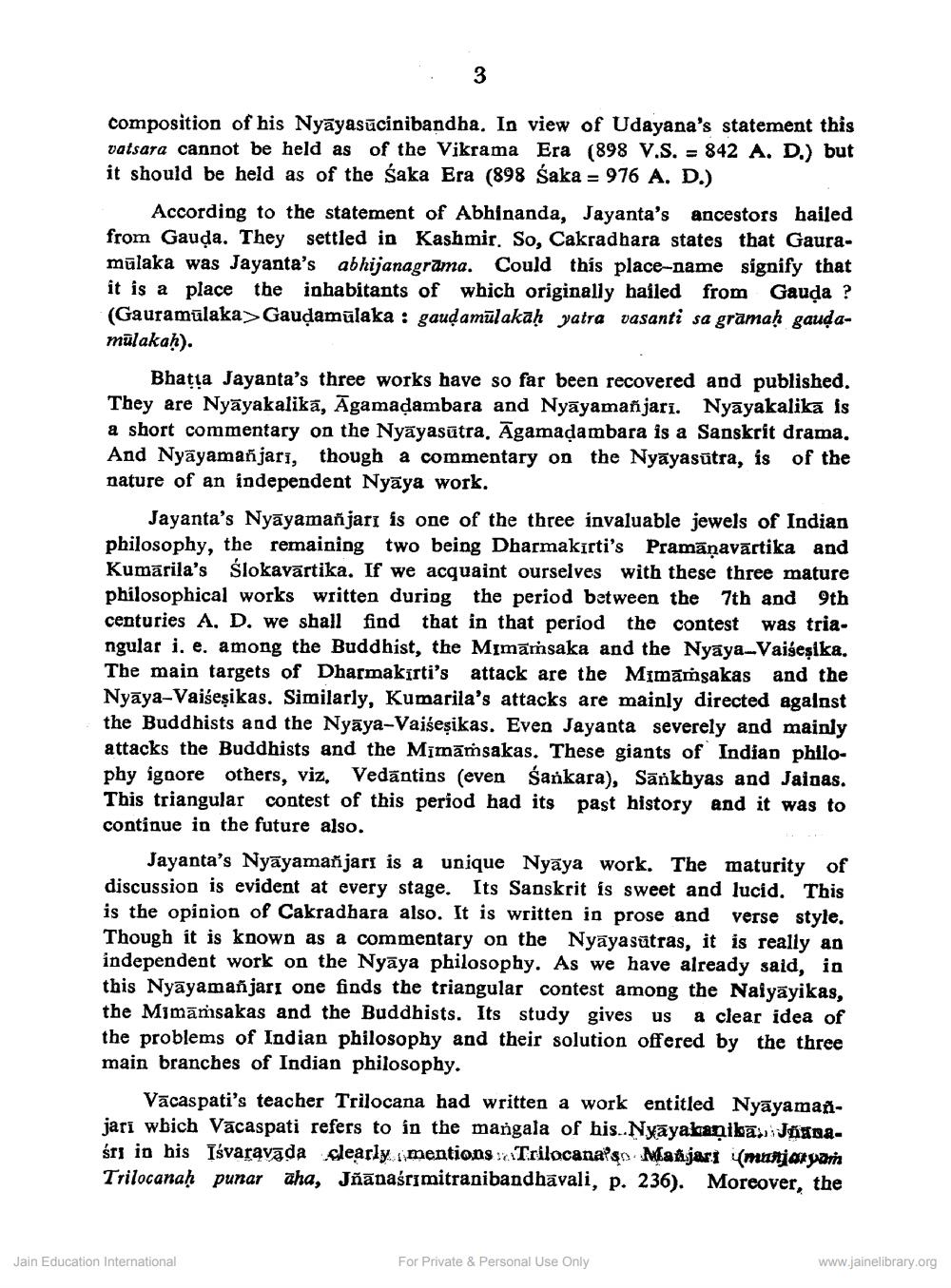________________
composition of his Nyāyasūcinibandha. In view of Udayana's statement this vatsara cannot be held as of the Vikrama Era (898 V.S. = 842 A. D.) but it should be held as of the saka Era (898 Śaka = 976 A. D.)
According to the statement of Abhinanda, Jayanta's ancestors hailed from Gauda. They settled in Kashmir. So, Cakradhara states that Gauramülaka was Jayanta's abhijanagrama. Could this place-name signify that it is a place the inhabitants of which originally hailed from Gauda ? (Gauramülaka>Gaudamülaka : gaud amūlakaḥ yatra vasanti sa grāmaḥ gaudamülakaḥ).
Bhatia Jayanta's three works have so far been recovered and published. They are Nyāyakalikā, Āgamadambara and Nyāyamañjari. Nyāyakalika is a short commentary on the Nyayasūtra, Āgamadambara is a Sanskrit drama. And Nyāyamanjarı, though a commentary on the Nyāyasūtra, is of the nature of an independent Nyāya work.
Jayanta's Nyāyamañjari is one of the three invaluable jewels of Indian philosophy, the remaining two being Dharmakīrti's Pramāņavārtika and Kumārila's ślokavārtika. If we acquaint ourselves with these three mature philosophical works written during the period between the 7th and 9th centuries A, D, we shall find that in that period the contest was triangular i. e. among the Buddhist, the Mimārsaka and the Nyāya-Vaiseșika. The main targets of Dharmakirti's attack are the Mimāṁsakas and the Nyāya-Vaiseșikas. Similarly, Kumarila's attacks are mainly directed agalast the Buddhists and the Nyāya-Vaiseșikas. Even Jayanta severely and mainly attacks the Buddhists and the Mimāṁsakas. These giants of Indian philophy igaore others, viz. Vedāntins (even Sankara), Sankhyas and Jaioas. This triangular contest of this period had its past history and it was to continue in the future also.
Jayanta's Nyāyamañjari is a unique Nyāya work. The maturity of discussion is evident at every stage. Its Sanskrit is sweet and lucid. This is the opinion of Cakradhara also. It is written in prose and verse style. Though it is known as a commentary on the Nyāyasūtras, it is really an independent work on the Nyāya philosophy. As we have already said, in this Nyāyamañjari one finds the triangular contest among the Naiyāyikas, the Mimāṁsakas and the Buddhists. Its study gives us a clear idea of the problems of Indian philosophy and their solution offered by the three main branches of Indian philosophy.
Vācaspati's teacher Trilocana had written a work entitled Nyāyamanjari wbich Vacaspati refers to in the mangala of his..Nyāyakaạikā, Jūnnaśrs in his Isvaravada clearly mentions:Trilocanaiso Manjari manjar yar Trilocanaḥ punar aha, Jñānaścımitranibandhavali, p. 236). Moreover, the
Jain Education International
For Private & Personal Use Only
www.jainelibrary.org




